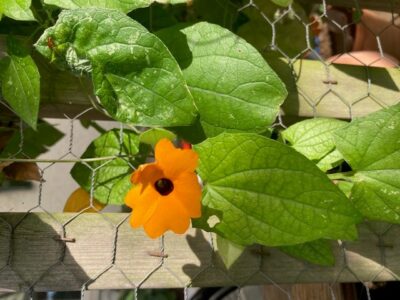Now that the greenhouse has been emptied of the mass of soft green growth that fills it over summer – mainly tomatoes, which are now thoroughly over, those many that didn’t ripen sitting preserved in chutney in the cupboard – I can think about how I might use it over winter. One of the ways is to overwinter plants that are on the cusp of hardiness, or that just enjoy a tiny bit of shelter over winter, aeoniums and pelargoniums in particular. I’ve also decided to try to overwinter a black eyed Susan vine, Thunbergia alata, this winter, but it needs a little more warmth than my cold greenhouse can provide.

Black eyed Susan vines are beautiful, vigorous vines that in full sun will be covered in glorious bright orange flowers all summer. In cool climates such as the UK we grown them as annual climbers, sowing them in early spring, planting them out in late spring or early summer, and then letting them scramble and bloom all summer long. They are frost tender, and so in autumn we just leave them to get hit by the frost and die, knowing that we can replace them with new plants next spring. But they are not actually annuals. They are perennials and in warmer climates they will grow and flower all year long. I thought it might be fun to try to overwinter one.
My first thought was to use the greenhouse, but it is simply not warm enough. Black eyed Susans will do well in a well-insulated heated greenhouse, but I leave mine entirely cold and pretty much uninsulated. It really just keeps the rain off and any real cold snap will hit the plants inside it pretty hard. A black eyed Susan will thrive in a conservatory, where it has the heat of the house to keep it going, but again these are not conditions I can replicate in the greenhouse.
Instead I am going to try growing it as a houseplant. It is a bit of a funny one to grow as a houseplant simply because it is so vigorous, and I will need to put supports in place to allow it to climb and climb, up to around 8ft, in theory. But I love the idea of it scrambling all around my sunniest room all winter, if it thrives. I’ve started things off by cutting it right down to size to make it moveable, digging it up from the large pot that it has sat in all summer, with as much of its rootball as possible still intact. I have potted this up into a smaller container of fresh compost and for now it is still in the greenhouse, just gradually acclimatising to a little indoor life.
Winter for houseplants can be a tough time. They generally don’t react well to heating which dries them out and leads to browning, crispy leaves, and the light levels get very low. It is a great idea to invest in a mister to spray the leaves regularly in order to keep the humidity high around the leaves and prevent crisping.
I will definitely need to do this for my black eyed Susan as it has very delicate leaves that I can imagine crisping at the merest whiff of dry air. In truth I can’t imagine that it will particularly thrive as a houseplant, but with a bit of luck I will be able to at least keep it alive, and next spring it will be a much bigger plant, and will start to flower much earlier in the year than a plant grown from spring seed would.










